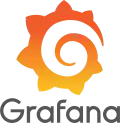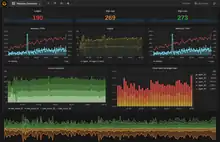Grafana
Grafana is a multi-platform open source analytics and interactive visualization web application. It can produce charts, graphs, and alerts for the web when connected to supported data sources.
 | |
 | |
| Developer(s) | Grafana Labs |
|---|---|
| Stable release | 10.4.2[1]
/ 11 April 2024 |
| Repository | |
| Written in | Go and TypeScript |
| Operating system | Microsoft Windows, Linux, macOS |
| Type | Business intelligence |
| License | GNU Affero General Public License, version 3.0 |
| Website | grafana |
There is also a licensed Grafana Enterprise version with additional capabilities, which is sold as a self-hosted installation or through an account on the Grafana Labs cloud service.[2] It is expandable through a plug-in system. Complex monitoring dashboards[3] can be built by end users, with the aid of interactive query builders. The product is divided into a front end and back end, written in TypeScript and Go, respectively.[4]
As a visualization tool, Grafana can be used as a component in monitoring stacks,[5] often in combination with time series databases such as InfluxDB, Prometheus[6][7] and Graphite;[8] monitoring platforms such as Sensu,[9] Icinga, Checkmk,[10] Zabbix, Netdata,[7] and PRTG; SIEMs such as Elasticsearch[6] and Splunk; and other data sources. The Grafana user interface was originally based on version 3 of Kibana.[11]
History
Grafana was first released in 2014 by Torkel Ödegaard as an offshoot of a project at Orbitz. It targeted time series databases such as InfluxDB, OpenTSDB, and Prometheus, but evolved to support relational databases such as MySQL/MariaDB, PostgreSQL and Microsoft SQL Server.[12]
In 2019, Grafana Labs secured $24 million in Series A funding.[13] In the 2020 Series B funding round it obtained $50 million.[14] In the 2021 Labs Series C funding round, Grafana secured $220 million.[15]
A conference, GrafanaCon 2020, scheduled for May 13–14, 2020, in Amsterdam, was changed to an online live streaming event during the COVID-19 pandemic.[16][17]
Adoption
Grafana is used[5] in Wikimedia's infrastructure.[20] Grafana has over 1000 paying customers, including Bloomberg, JP Morgan Chase, eBay, PayPal, and Sony.[18]
Licensing
Previously, Grafana was licensed with an Apache License 2.0 license and used a CLA based on the Harmony Contributor Agreement.[21]
Since 2021, Grafana has been licensed under an AGPLv3 license.[22] Contributors to Grafana need to sign a Contributor License Agreement (CLA) that gives Grafana Labs the right to relicense Grafana in the future. The CLA is based on The Apache Software Foundation Individual Contributor License Agreement.[23]
Products
Open source
- Loki - a log aggregation platform based on Prometheus first made available in 2019[24]
- Mimir - a metric visualization tool released in 2022 that replaced Cortex[25]
- Tempo - a tool for log tracing, released in 2021[26]
References
- "Release 10.4.2". 11 April 2024. Retrieved 23 April 2024.
- "Grafana Enterprise Stack". Grafana Labs. Retrieved 2021-03-19.
- Perrin, Jim. "Monitoring Linux performance with Grafana". OpenSource.com. Retrieved 2018-08-14.
- Synopsys. "The grafana Open Source Project on Open Hub: Languages Page". Open Hub. Retrieved 2021-03-19.
- Anadiotis, George. "DevOps and observability in the 2020s". ZDNet. Retrieved 2020-02-04.
- Jones, Anna (2019-01-25). "Open Source Monitoring Stack: Prometheus and Grafana". Bizety. Retrieved 2019-05-08.
- DeLosSantos, Louis (2018). "Netdata, Prometheus, Grafana stack". Netdata Documentation. Retrieved 2019-05-08.
- Assaraf, Ariel. "Grafana Vs Graphite". Coralogix.
- Kumar, Santhosh; Muruganantham, Logeshkumar (2017-01-21). "Step By Step: Install and Configure Sensu + Grafana". Powerupcloud Tech Blog. Archived from the original on May 8, 2019. Retrieved 2019-05-08.
- "Exporting Check_MK Performance Data to Grafana". TruePath Technologies. 2018. Retrieved 2020-09-24.
- Ödegaard, Torkel (2019-09-03). "The (Mostly) Complete History of Grafana UX". grafana.com. Retrieved 2020-10-06.
- "MySQL data source | Grafana documentation". Grafana Labs. Retrieved 2024-04-23.
- Anadiotis, George. "Is open source the way to go for observability? Grafana Labs scores $24M Series A funding to try to prove this". ZDNet. Retrieved 2020-02-04.
- Grafana (2020-08-17). "Grafana Labs Raises $50 Million to Accelerate R&D Investments in Open Source Logs, Metrics and Composable Observability". GlobeNewswire News Room. Retrieved 2021-07-23.
- Grafana (2021-08-24). "Grafana Labs Raises $220 Million Round at $3 Billion Valuation". Bloomberg. Retrieved 2021-08-22.
- "GrafanaCon 2020". Retrieved 2020-05-04.
- Dam, Julie (2019-12-12). "Register Now! GrafanaCon 2020 Is Coming to Amsterdam May 13-14". grafana.com.
- "Grafana Labs acquires load-testing startup K6". VentureBeat. 2021-06-17. Retrieved 2021-07-27.
- "Grafana Labs Acquires k6 to Add Open Source Load Testing Tool - DevOps.com". devops.com. Retrieved 2021-07-27.
- "grafana.wikimedia.org". Wikitech. Retrieved 2021-04-09.
- "Grafana Labs Contributor License Agreement". Retrieved 2021-01-22.
- Dutt, Raj (2021-04-20). "Grafana, Loki, and Tempo will be relicensed to AGPLv3". grafana.com. Retrieved 2021-04-21.
- "Grafana Labs Contributor License Agreement". grafana.com. 2021-04-20. Retrieved 2021-04-21.
- Lobo, Savia (November 20, 2019). "Grafana Labs announces general availability of Loki 1.0, a multi-tenant log aggregation system". Packt Hub. Retrieved 19 April 2023.
- Gain, B. Cameron (August 10, 2022). "The Great Grafana Mimir and Cortex Split". The New Stack. Retrieved 19 April 2023.
- Deutscher, Maria (June 8, 2021). "Grafana Labs eases IT monitoring with Tempo tracing tool and new Grafana release". Silicon Angle. Retrieved 19 April 2023.